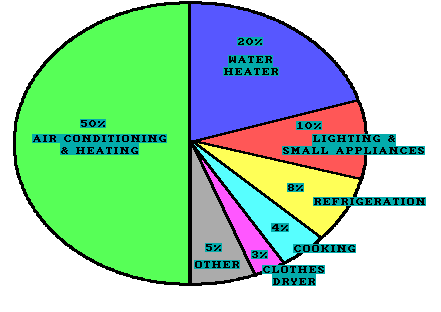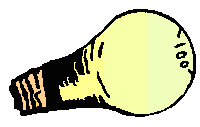APPLIANCES: YOUR CHOICE CAN
AFFECT ENERGY CONSUMPTION
- GOAL:
- The student will understand that the proper use, placement, and care of appliances can increase overall energy efficiency.
- OBJECTIVES:
- The student will be able to:
- 1. Calculate energy use and operating costs of household appliances.
- 2. State suggestions and strategies for reducing costs of operating household appliances.
- LESSON / INFORMATION:
- Not including the central air conditioning and heating unit, which can use up to ONE HALF of the total home energy budget, most of the energy in the home is spent operating a variety of appliances. The breakdown of the home energy budget (based on electricity use) follows this general outline:

- Many people are not aware of how much energy it takes to operate the multitude of appliances found in the home.
- ACTIVITY 1:
- Rank the following appliances according to their energy consumption. Which do you think uses the most energy? Place an "A" next to that item. Continue on through "E."
- _____1. Washing machine
- _____2. Iron
- _____3. Water heater
- _____4. Range top
- _____5. Ceiling fan
- There is an easy way to determine the amount of energy an appliance uses. To compute energy used by appliances, assume that these appliances are operated by electricity. Therefore, the energy used can be measured in kilowatt (kWh) hours.
- Kilowatts may best be understood using light bulbs as an example.
- A 100-watt bulb uses 100 watts of electricity in an hour. In 10 hours this bulb would use 1000 watts of electricity.

- One, 100-watt bulb burning for 10 hours would use 1000 watts, or 1 kilowatt, of electricity.
- 100 watts/hr. x 10 hrs. = 1000 watts
- 1000 watts = 1 kilowatt (kWh)
- While the cost per kWh varies, 7-1/2¢ ($.075) per kWh is a good average. Thus, from the example above, to use a 100-watt bulb for 10 hours, or 1 kWh, would cost about 7-1/2¢.
- It is easy to figure out the cost of operating a home appliance per hour of use.
- ACTIVITY 2:
- A. If the wattage is given, divide the wattage by 1000 to get kWh. Then multiply by the cost of a kWh, approximately 7-1/2¢ ($.075), to get cost of operation per hour.
- Example: For a 1200-watt hair dryer:
- 1200 / 1000 = 1.2 kWh
- 1.2 x $.075 = $.09 (9¢/hr.)
- If a refrigerator has a wattage of 330, how much does it cost to run that appliance for
- an hour?_________
- a day?_________
- B. If the wattage is not given, look on the appliance for voltage and amp information. Multiply volts by amps to get wattage. Then divide wattage by 1000 to get kWh. Multiply kWh by the cost per kWh, assume 8¢ ($.08) for this problem, to get cost of operation per hour.
- Example:
- For a 115 volt, 9 amp toaster:
- 115 x 9 = 1035 watts
- 1035 / 1000 = 1.035 kWh
- 1.035 x $.08 = $.0828 (8.28¢ /hr.)
- If a washer has a voltage of 115 and the amps listed is 25, how much does it cost to operate the washer, at 8¢ per kWh, for
- an hour?_________
- 3 hours?___________
- Now that you know how to determine kilowatt hours used and the cost of operating an appliance, you can check your answers to ACTIVITY 1. Using the following information, figure the cost of operating each appliance for one hour. Assume kWh cost at 6¢ ($.06) per kWh. Now, which costs the most? Which costs the least?
- 1. Washing machine (520 watts). Cost = _______________
- 2. Iron (1000 watts). Cost = _______________
- 3. Water heater (4500 watts). Cost = _______________
- 4. Range top (2000 watts). Cost = _______________
- 5. Ceiling fan (180 watts). Cost = _______________
- Now that you know how to determine kilowatt hours used and the cost of operating an appliance, how can you reduce these costs? There is much information on this topic. Here are some general rules to follow:
- 1. Reduce appliance use whenever possible. Also use appliances appropriate to the size of the job.
- - Turn the thermostat down in the winter (to 68°F) and up in the summer (to 78°F).
- - Use fans to supplement air conditioning.
- - Wash dishes or clothes by hand when possible. Hang clothes out to dry.
- - Wash only full loads in the dishwasher or washing machine.
- - Use less hot water.
- - Wash clothes in cold water when possible.
- - Dry several loads in succession; do not overdry clothes.
- - Cook in covered pans to conserve heat.
- - Cook or bake many items at once.
- - Use the microwave or electric skillet instead of the range or oven.
- - Use maximum allowable settings on the refrigerator and freezer.
- - Keep freezer full to help maintain temperature.
- - Do not overfill refrigerator; air in the refrigerator needs to circulate in order to cool efficiently.
- 2. Place appliances properly.
- - Keep the refrigerator and freezer away from sun or heat producing appliances. Do not place them in areas of the building that are not air conditioned.
- - Keep the thermostat out of direct sunlight. Shade the outside portion of the air conditioning unit.
- - House the water heater and home heating system in the warmest place possible.
- - Have adequate venting around the stove and clothes dryer so that humidity is released outside the house.
- 3. Care for and maintain appliances.
- - Install appliances as directed by the manufacturer.
- - Keep up with scheduled maintenance on all appliances.
- - Clean cooling coils on refrigerators and freezers.
- - Periodically remove sediment from water heaters.
- - Clean the fins on the outside portion of the air conditioner.
- - Periodically change air conditioner filter.
- - Keep doors and hinges well lubricated and in working order.
- - Keep vents and exhaust pipes clear of debris.
- Always be on the lookout for hints from appliance manufacturers on how to properly use their product for maximum energy savings.
- RESOURCES:
- II.1 Reading Your Electric Meter. Florida Middle School Energy Education Project. Florida Solar Energy Center, Cape Canaveral, FL, 1989.
- How far does (1) Kilowatt hour (kWh) Go!! SLEMCO, Lafayette, LA, n.d.
- Your Lifestyle Can Make a Difference. SLEMCO, Lafayette, LA, n.d.
- Providing for Energy Efficiency in Homes and Small Buildings, Part 1. U.S. Department of Energy, 1980.
- INFORMATION CHECK
- Place a "T" in front of a statement that is true and an "F" in front of a statement that is false. Under each false statement, explain why it is false.
- _____1. Up to 50% of the home energy budget may be spent on heating and cooling.
- _____2. Up to 20% of the home energy budget may be spent on the water heater.
- _____3. Besides the heating and cooling system, the washing machine is the appliance that uses the most energy.
- _____4. A 60-watt bulb used for 60 hours would use one (1) kilowatt of electricity.
- _____5. The cost of a kilowatt hour of electricity varies; a good average is about $7.50 an hour.
- _____6. It would use less energy to warm canned vegetables in the microwave as compared to the range top or oven.
- _____7. In a cold climate, the best place to put the water heater would be in the unheated basement.
- _____8. Regular maintenance on appliances is usually costly and a waste of time.
- _____9. To save energy, keep the refrigerator as full as possible.
- _____10. Avoid using fans for cooling; they are costly to operate.
- _____11. It is better to wash and dry one load of clothes every day than to do several loads in succession.
- _____12. A T.V. using 200 watts of electricity per hour could be operated for 5 hours and only cost about 7 1/2¢.
- _____13. Energy will be lost on such items as blocked dryer vents, refrigerator doors that do not seal properly, and oven doors that allow heat to escape.
- _____14. If you were only going to do one thing to reduce your energy use in Louisiana, the best thing to do would probably be to reduce air conditioner usage.
- _____15. It is better to boil water in a kettle than an open pot.
- TEACHER'S NOTES
- ACTIVITY 1:
- 1. d
- 2. c
- 3. a
- 4. b
- 5. e
- ACTIVITY 2:
- A. 2.48¢ an hour and 59.4¢ a day
- B. 23¢ an hour and 69¢ a day
- 1. = 3.12¢
- 2. = 6¢
- 3. = 27¢
- 4. = 12¢
- 5. = 1.08¢
- DEFINITIONS:
- 1. Home energy budget -
- This refers to the total amount of money available for residential energy use. For most students this will be reflected by the cost of electricity, natural gas, or both.
- 2. Kilowatt hour (kWh) -
- A unit of power that measures electricity use. One kWh is used each time 1000 watts of electric power is used.
- 3. Wattage -
- The wattage of an appliance refers to the number of watts of electricity used in one hour of operation. A 1500-watt hair dryer uses 1500 watts of electricity in one hour. Wattage is usually given on the appliance.
- 4. Reducing energy usage by home appliances -
- This focuses on using the appliance less, on placing it correctly within the house, on keeping the appliance clean and well-maintained, and on using the appliance as directed for maximum energy savings.
- ANSWERS TO INFORMATION CHECK:
- 1. True
- 2. True
- 3. False - The washing machine is really not a big energy user. The water heater would probably follow the heating and cooling system.
- 4. False - A 60-watt bulb burning 60 hours would use 60 x 60 or 3600 watts of electricity; this is 3.6 kWh.
- 5. False - An average for kWh cost is about 7-1/2¢.
- 6. True
- 7. False - The water heater will run more to maintain water temperature if placed in a cold, unheated basement.
- 8. False - Regular cleaning and maintenance helps the appliance use energy more efficiently and thus saves on energy costs.
- 9. False - A refrigerator that is too full will not allow the cold air to circulate and will have to work harder to keep foods cold.
- 10. False - As the air conditioner uses many times more energy than fans, it would be helpful to use fans instead of, or along with, the air conditioner.
- 11. False - It is better to dry all loads in succession as the dryer will already be warm.
- 12. True
- 13. True
- 14. True
- 15. True
Comments or questions to: TechAsmt@LA.GOV
Return to Home Energy Menu


